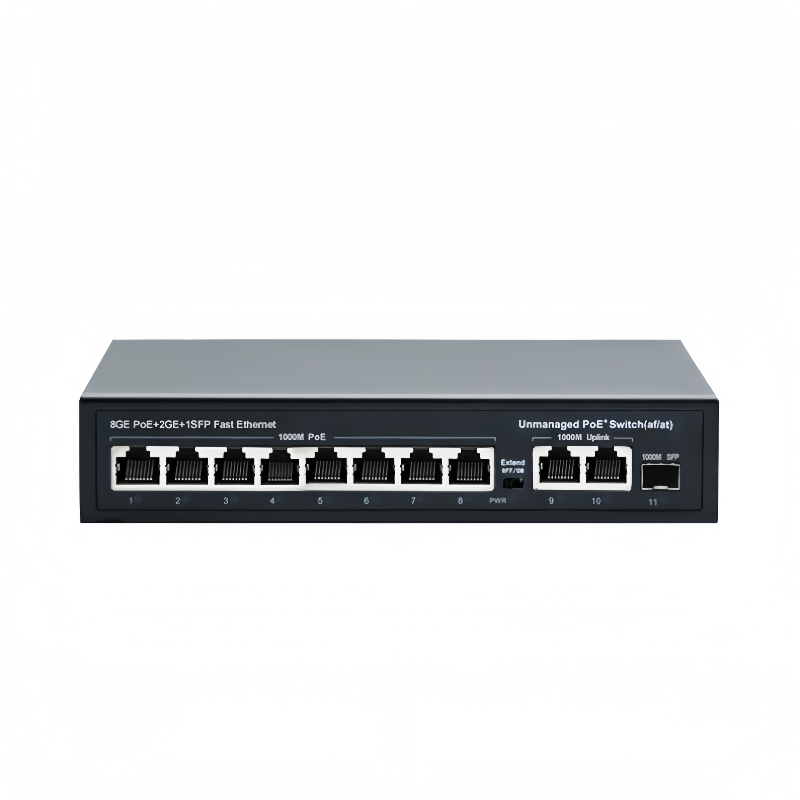Understanding PoE Switch Fundamentals
What is Power over Ethernet?
Power over Ethernet, or PoE for short, lets electricity travel through regular Ethernet cables at the same time as data moves between devices. What makes this tech so useful? Well, it cuts down on all those extra power cords we normally need, which means setting up stuff like security cameras, voice over IP phones, and Wi-Fi routers becomes much less of a headache. When devices can get power right from their data cable, whole networks become simpler and cheaper to install. The rise of smart gadgets connected to the internet has really pushed PoE into the spotlight lately. With so many new things getting added to networks every day, being able to send both power and information through one wire just makes everything work better together in offices, factories, and even our homes.
PoE Standards Explained
Knowing which Power over Ethernet standards apply makes a big difference when it comes to getting network gear to work together properly. Let's look at the main ones first: There's the older 802.3af standard that gives around 15 watts per port, then came 802.3at or PoE+ with about double that at 30 watts. The latest kid on the block is 802.3bt (also called PoE++) capable of pushing out up to 100 watts per port. Sticking with these standards isn't just good practice it's pretty much required if companies want their switches, cameras, phones and other devices to play nice together. According to recent market analysis, adoption of compliant PoE tech has been growing fast particularly among large organizations deploying smart buildings and IoT systems. When businesses follow these specs they end up with networks that actually work as intended without random dropouts or power issues affecting everything from security cameras to VoIP phones throughout the facility.
PoE Switch Types and Performance Levels
Unmanaged vs Managed Switch Differences
Picking out a PoE switch means knowing what separates unmanaged from managed models. Unmanaged switches are simple plug-and-play devices that just work right out of the box without needing any setup or configuration. These tend to cost less money since they don't come packed with extra features or advanced controls for managing networks. Managed switches tell another story entirely though. They let administrators tweak settings, keep tabs on traffic flows, and boost overall network performance while adding layers of security protection. These professional grade switches handle things like VLAN configurations, Quality of Service parameters, and all sorts of monitoring tools that make them perfect for big offices or corporate campuses where network demands get complicated fast. Most companies that grow beyond basic operations end up going with managed solutions because they need that flexibility when scaling up infrastructure over time. The choice really comes down to matching equipment capabilities with actual operational requirements and financial constraints.
Hybrid PoE Switches Overview
Hybrid PoE switches give flexible connectivity since they work with both Power over Ethernet (PoE) and regular Ethernet connections. This flexibility really helps out in places where there are some PoE devices mixed in with older non-PoE ones. Think about modern office buildings or factories that run all sorts of different equipment side by side. These hybrid switches let everything connect smoothly without tearing down the whole network setup just to make room for new tech. Real world tests show that companies can boost their network performance quite a bit when they install these switches. Many businesses have actually grown their network reach using hybrid models because they handle so many different device types at once. Plus, it saves money on infrastructure upgrades compared to replacing everything outright.
By choosing the right type of PoE switchâbe it unmanaged, managed, or hybridâyou are poised to address your network needs effectively, ensuring robust performance and efficient power management.
Key Selection Criteria for PoE Switches
Power Budget Calculation Essentials
Picking out the right PoE switch means knowing how to figure out the total power budget so every connected device gets enough juice. Basically, we need to add up what each PoE enabled gadget needs - think IP cameras, VoIP phones, wireless access points - then make sure the switch can handle more than that total amount. Otherwise things get underpowered and networks suffer. Let's look at some real world numbers. Most IP cameras eat about 15.4 watts, VoIP phones typically draw around 7 watts, while those wireless access points can gobble up close to 30 watts each. A lot of companies still mess this up though. Recent industry reports show many businesses consistently lowball their actual power requirements, which leads to all sorts of headaches down the road. That's why smart tech managers always take time upfront to properly map out these power needs before deployment, keeping the whole network running smoothly without unexpected dropouts or failures.
Port Requirements Assessment
Port requirements represent a critical consideration when looking at PoE switches for network infrastructure. Network administrators must figure out exactly how many ports they'll need now for existing equipment plus account for expansion down the road. Different port options exist including standard ones for everyday devices, uplink ports that link to additional switches or main network hubs, and specialized PoE ports that deliver both data and power. According to industry reports, most business networks experience around 20% growth in connected devices within five years. This means selecting a switch with enough spare ports becomes essential for long term planning. A smart choice today prevents costly upgrades later and keeps the network ready to handle whatever new technology comes along in the coming years.
Evaluating Your Network Requirements
Use Case Scenarios Analysis
Getting familiar with how Power over Ethernet (PoE) switches work in different situations helps companies get the most out of them. We see these switches being used all over the place actually—in offices, security setups, and those fancy smart buildings too. They power things like security cameras, voice over IP phones, and even those LED lights that adjust automatically. The big advantage? Cheaper setup since there's no need for separate power lines, plus operations run smoother overall. With so many internet connected gadgets popping up everywhere nowadays, more businesses are jumping on the PoE bandwagon. Take a look around any tech forward company and chances are good they've already integrated PoE into their network infrastructure somewhere.
Device Compatibility Considerations
Getting PoE switches to work well with all connected gear matters a lot when setting up networks properly. The whole thing starts by looking at several things including what kind of PoE standard applies and how much power each device actually needs. Most folks should check if their equipment follows standards like 802.3af, 802.3at, or the newer 802.3bt specs because this determines whether enough power gets delivered correctly. Before plugging anything into the system, it pays off to spend some time going through spec sheets and reading what the manufacturers say about compatibility. A lot of companies now publish compatibility charts online that save headaches later on. These charts help avoid situations where devices don't function right after installation. By referencing actual technical data from reliable sources, network administrators can set up PoE systems that not only work today but will also handle whatever new devices might come along in the months ahead.
Advanced Features Comparison
VLAN and QoS Requirements
Getting to grips with what VLANs and QoS do makes all the difference when trying to get the most out of a network while keeping important devices running smoothly. A VLAN basically lets us split up a network into smaller parts, making it easier to manage how data moves around. Think of it like creating separate rooms inside one big house instead of letting everyone just wander through together. These virtual networks work within the same physical infrastructure, so companies save money on extra equipment while still improving both speed and protection against security threats. Then there's Quality of Service (QoS), which acts like traffic police for data packets. It tells the network which information needs to move faster than others, giving priority to stuff that really matters. This comes in handy during those moments when something like phone calls between offices or live meetings starts lagging because someone else is downloading huge files in the background.
Installation Environmental Factors
Environmental conditions matter a lot when setting up a PoE switch. Temperature extremes, humidity levels, and proper air circulation all affect how well the device works and how long it lasts. Most manufacturers specify ideal operating ranges for their switches, usually between certain degrees Fahrenheit and relative humidity percentages. Sticking close to these guidelines makes sense because extreme heat can cause components to fail prematurely, while too much moisture leads to corrosion problems down the road. Good ventilation around the switch isn't just nice to have either it's essential for keeping things cool enough to function properly. Real world installations consistently show better results when placed in controlled environments versus those stuck in hot server rooms or damp basements. Taking the time to assess temperature fluctuations, moisture risks, and airflow availability before mounting the switch will save headaches later on and ensure stable network performance throughout its service life.

Implementation Best Practices
Cabling and Heat Management
Getting the cabling right and managing heat properly makes all the difference when it comes to keeping a PoE switch running reliably over time. Good quality cables matter a lot for performance and cutting down on power losses. Cheap cables tend to have higher resistance, which means more power gets wasted and overall efficiency drops off. Heat management is just as important too. Make sure there's enough airflow around the equipment, maybe install some fans if needed, or add heat sinks where appropriate. These simple steps stop switches from getting too hot and keep them performing at their best. Network administrators who pay attention to these basics generally see fewer problems down the road, since most failures related to overheating simply don't happen anymore.
Future-Proofing Your Setup
Making sure PoE switches remain relevant over time represents smart planning for networks facing constant technological changes. A good tactic when setting up these systems is to go with switches that can scale up easily and adapt well to different situations, making it simpler to bring in new gear later on. Look at models with modular components or ones compatible with newer PoE standards since they'll handle greater power requirements as infrastructure expands. Many IT teams now stress how critical this preparation actually is, backed by recent market research showing most organizations prefer flexible network setups these days. Beyond just avoiding outdated equipment, proper planning leads to better performance metrics and saves money down the road while businesses grow their operations across multiple locations.
FAQ Section
What is the significance of PoE standards?
PoE standards like IEEE 802.3af, 802.3at, and 802.3bt ensure compatibility and optimal performance of network devices. Adhering to these standards helps in building robust and reliable networks.
How do managed and unmanaged PoE switches differ?
Unmanaged switches offer simplicity with a plug-and-play setup, while managed switches allow for advanced configuration, monitoring, and network management, enhancing performance and security.
What are hybrid PoE switches?
Hybrid PoE switches support both PoE and traditional Ethernet connections, allowing for versatile connectivity and seamless integration in environments with mixed PoE and non-PoE devices.
How do you calculate the power budget for a PoE switch?
Calculating a PoE power budget involves adding the power requirements of all connected devices and ensuring the switch's power budget exceeds this total to maintain network stability.
Why are VLAN and QoS important in PoE switches?
VLAN segments networks for better management, while QoS prioritizes data transmission, ensuring reliable performance for critical applications like VoIP or video conferencing.

